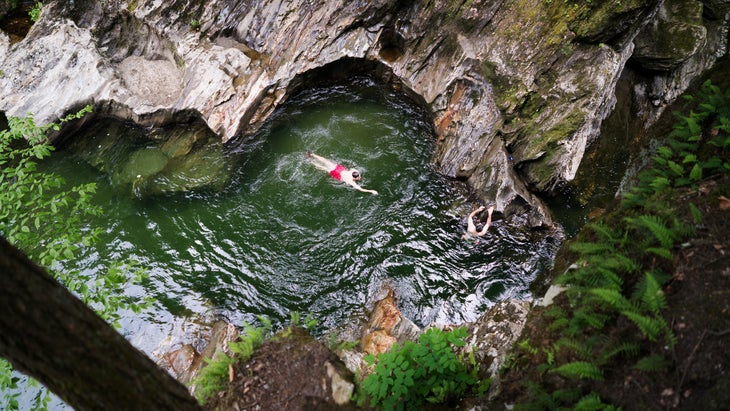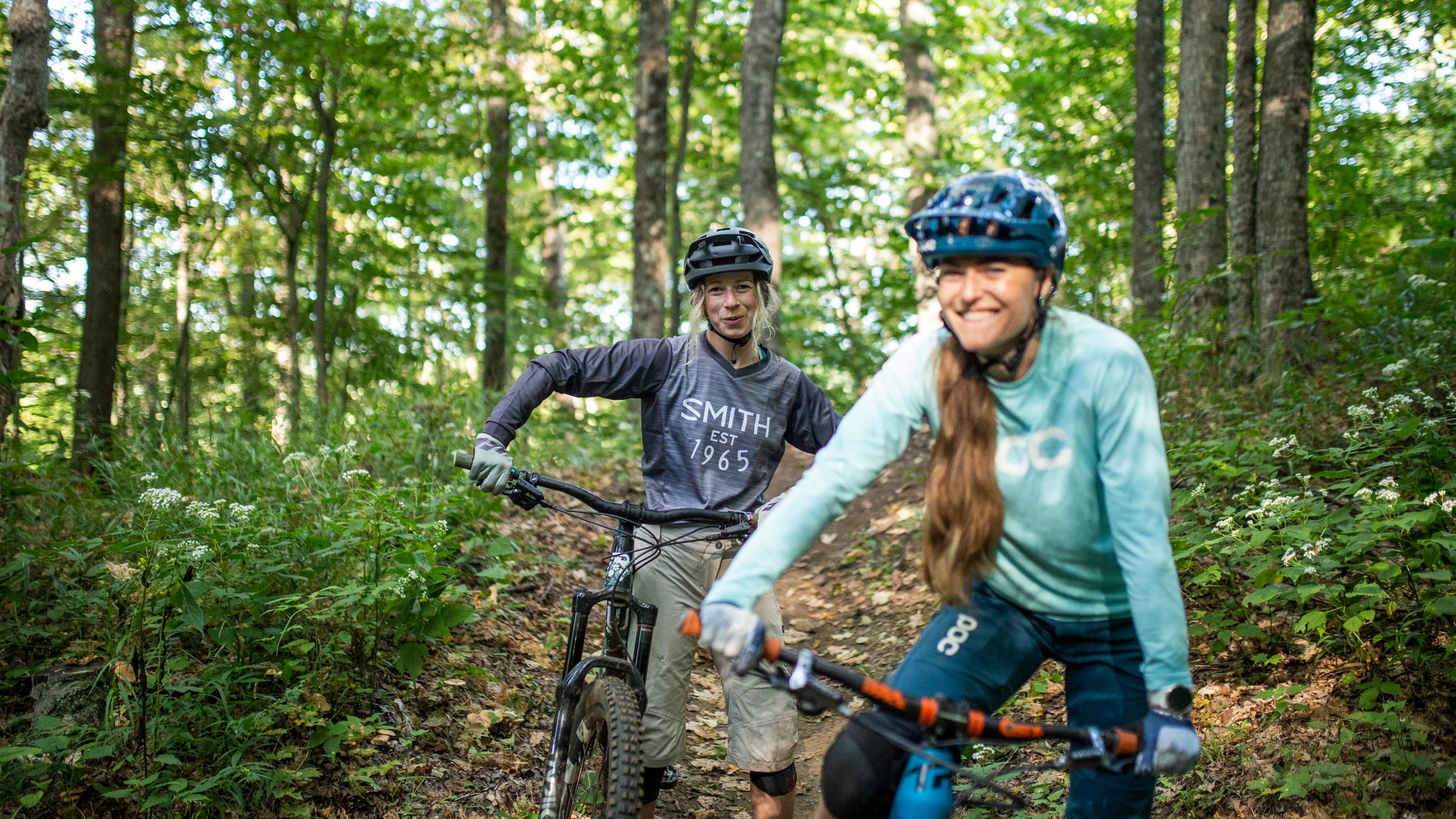World-class outdoor destinations like Vermont don’t just materialize out of the ether. Manicured trails, clean rivers, equitable access, habitat restoration, and even the tucked-away swimming holes Vermont is famous for—all those amenities take volunteers and paid professionals dedicating hours and lifetimes to the cause. It’s work that engages communities, stimulates economies, and preserves outdoor areas for generations to come. Want to experience the result of all that on your next visit to Vermont? Here’s a sampling to get you started.
Releasing a River
Since 1952, the has fought for the river that separates Vermont and New Hampshire. It’s been a struggle, but now the river is along its entire stretch through Vermont. In addition to organizing cleanups, riparian restoration, and dam removal in the Connecticut’s tributaries, the Conservancy is making a big push for recreation access. “Because the river runs through rural Vermont,” says the Conservancy’s Kathy Urffer, river steward for Vermont and New Hampshire, “traditionally it’s been hard to access. But because you only protect what you know and love, we’re working to change that. The river is the largest untapped recreational opportunity in the region.”��
Plan Your Visit: Today it’s possible to (from its headwaters near the Canadian border to Long Island Sound, with portages, of course), camping at 50 dedicated sites along the way. For shorter outings in Vermont, paddlers should target the faster-flowing stretches beneath dams and try to end the day at a campsite before the next portage. Down in southern Vermont? Check out the below the Vernon Dam.��
Helping Everyone Play
Participation in adaptive sports was churning before the pandemic because of improvements in gear, access, and instruction. With Vermont fully open again, the programs are more popular than ever. “People want to get outside these days,” says Vermont Adaptive’s Kim Jackson. “With adaptive sports, when you get one family member out, it gets the whole family out with them.” Here’s by the numbers: This year it expects to facilitate 3,000 outings in adaptive sports and programs with the help of 400 volunteers, 100 of whom are seasoned pros at teaching people with all manner of abilities to rip outdoors. The gear includes traditional and adaptive bikes, skis, snowboards, and watersports equipment. Those 400 volunteers generate 24,000 donated hours each year. “The volunteers are college students, doctors, retirees, recreation instructors, and physical therapists,” says Jackson. “We couldn’t do it without them.”
Plan Your Visit: ��In winter, Vermont Adaptive operates out of Pico and Bolton Valley ski areas—and a new 4,000-square-foot facility on the Glen Ellen side of Sugarbush. In summer you can take advantage of watersports on Lake Champlain. Mountain bikers in the Mad River Valley can take their pick: Vermont Adaptive has a fleet of vans loaded with adaptive and traditional bikes to shred on.

Saving Swimming Holes
When the (VRC) formed 26 years ago, the mission wasn’t to protect entire watersheds—it was to save �ձ�����DzԳ�’s legendary swimming holes. It’s vital work: if you’ve ever been to Vermont in summer, you know that swimming holes define the state during the warm months. But the hideaways are threatened by development and those who might not understand �ձ�����DzԳ�’s legacy of public access to private lands. Today, the Vermont River Conservancy—while it has expanded its work to include climate-change mitigation, habitat restoration, and access to waterways—still fights for swimming holes. It’s saved close to a hundred while educating users about how to care for them. “More and more we’re competing with the open real estate market,” says Steve Libby, VRC’s executive director. “But it’s worth it. Vermonters and visitors have enjoyed these spots for generations.”
Plan Your Visit: Every swimming hole matters, but the waterfall and swimming hole in Johnson is essential. And it was almost lost. Today, though, thanks to fast action by the Vermont River Conservancy, the 25-acre site and its 4,900 feet of waterfront are owned and managed by the town of Johnson. “We had dozens of partners and more than 120 individual donors,” says VRC’s Deputy Executive Director Richarda Ericson. “Each swimming hole has a story.” Looking for other hidden gems? Check out these in the state.
Growing Stewards
�ձ�����DzԳ�’s Northeast Kingdom is famous for not being famous. It’s here that you’ll find uncrowded spaces and remote, pristine forests. But the Kingdom should also be famous for the conservationists it raises. The began in 1989 to offer outdoor education to area youth; today, with 117 staff members on payroll (including 60 high school students in summer) and a 1,500-acre parcel of forest land they tend to, Northwoods stands on four pillars: environmental education, forest stewardship, conservation, and the all-important conservation corps, which heads out across the state and region building trail, restoring habitat, planting trees, removing invasive species, and creating trailheads. “All of our programs feed off each other,” says Maria Young, Northwoods’s executive director. “I’ve seen kids who were campers grow up to become crew chiefs with the corps.”
Plan Your Visit: Back in 2010, Northwoods Conservation Corps youth crews hewed out a trail in remote Essex County. Today, after 20 field sessions and the work of 120 local teens and young adults, there are now 20 miles of trail to explore in the . “Increasing access to wild places is a big part of what we do,” says the center’s Maria Young. “We want locals and visitors to see these less traveled parts of Vermont.”
Riding the Rail Trails
In rural areas of the state, repurposing the past for present day needs is something Vermonters do very well. For example, taking old rail lines and turning them into outdoor assets for walking, running, and cycling. That was the original idea behind northwest �ձ�����DzԳ�’s, which runs 26 miles from St. Albans on Lake Champlain through Enosburg Falls and onward and upward to Richford by the Canadian border. Today �ձ�����DzԳ�’s (NRPC) is expanding on what the trail can do for the communities along its route with a campaign to get the word out about the ride and an (plus physical signage) pointing to restaurants, shops, and community assets along the way. “The local residents covet the trail,” says Greta Brunswick, senior planner with the NRPC. “Now the goal is to fuel the recreation economy and drive traffic to trail-friendly stops. It’s a beautiful way to keep people active.”
Plan Your Visit: Northwestern Vermont is dairy country. Every little hamlet has at least one stand selling the special local version of soft-serve: creemees. With in hand and a cruiser bike beneath you, pick a few towns to connect between breakfast and lunch—paddling can also be had on the Missiquoi—and then cruise Enosburg Falls with a creemee.
Ready to Explore?
The aforementioned groups, programs, and projects represent just a small fraction of the work happening in Vermont—but they span clear across the Green Mountain State. Don’t forget that each of these areas are surrounded by historic downtowns, brewpubs, culinary and artisan markets, and so much more—the end of the trail is truly only the beginning. ��to discover endless opportunities for your own Vermont adventure.
��

